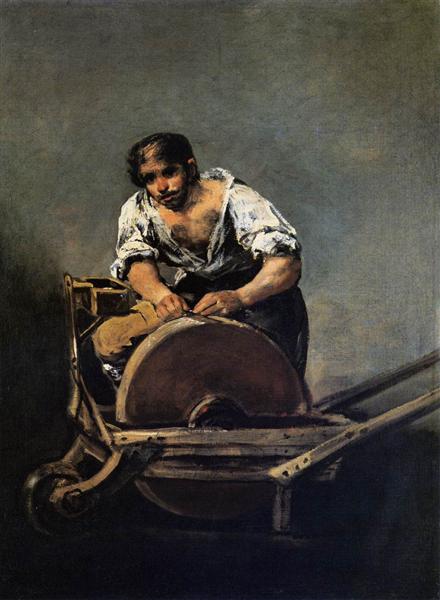Beskrivning
Francisco Goya's painting Knife Grinder (1812) is set in a complex and tumultuous period of Spanish history, marked by the Napoleonic invasion and the social upheavals that resulted from it. In this work, Goya captures the essence of human suffering and the tensions of his time through a sober and deeply observant approach that defines his mature and critical style. The painting, which depicts a man sharpening knives in a seemingly everyday scene, is actually a microcosm of the struggle and work of the working class in a context of crisis.
Visually, the work uses a palette of warm yellows and terracottas, which lend it a melancholic warmth. The grinder, the central character, is presented in an attitude of obvious physical effort, conveying not only the industriousness of his occupation but also the precariousness of his existence. His intensely focused face reflects a mix of determination and resignation. Goya, known for his ability to capture the complexity of the human condition, uses light and shadow to shape the figure of the man and the object he works on; the shine of the sharp metal stands out against the duller tones of the surroundings, emphasizing both the fragility of manual labor and its importance in difficult times.
The character's surroundings, though not overly detailed, are articulated with an upright and valid background that serves to amplify the grinder's sense of isolation. With the slightly tilted horizon and a composition that plays with the diagonal, Goya suggests not only a balanced composition, but also a subtle instability, an echo of the social precariousness of the time. This tilt can also be interpreted as a commentary on imminent change, the collapse of a society that is on the threshold of a profound transformation.
Unlike many of his earlier works, which often celebrated Spanish life and culture, "Knife Grinder" reflects Goya's disillusionment with the institutions and power structures of his time. With an almost realist approach, the artist moves away from idealized romanticism and approaches a cruder and more honest vision of the life of the lower classes, aligning himself with the current of European Romanticism that was beginning to take shape at that time.
In this work we can also see echoes of the tensions between tradition and modernity, a duality that permeates all of Goya's work. The grinder's trade can be seen as a representation of the artisan traditions that were in danger in the face of industrialization and other changes that were beginning to define the future of Europe in the 19th century.
"Knife Grinder" stands, then, not only as a portrait of a man at work, but as a powerful symbol of the sacrifice and struggle that characterized a threatened working class, while reminding us of Goya's ability to penetrate human psychology and capture the realities of his environment with an intense and sincere gaze. This work becomes a testament to his talent for, through the seemingly trivial, revealing profound truths about the human condition and the history that surrounds it.
KUADROS ©, a famous painting on your wall.
Hand-made oil painting reproductions, with the quality of professional artists and the distinctive seal of KUADROS ©.
Painting reproduction service with satisfaction guarantee. If you are not completely satisfied with the replica of your painting, we will refund 100% of your money.

